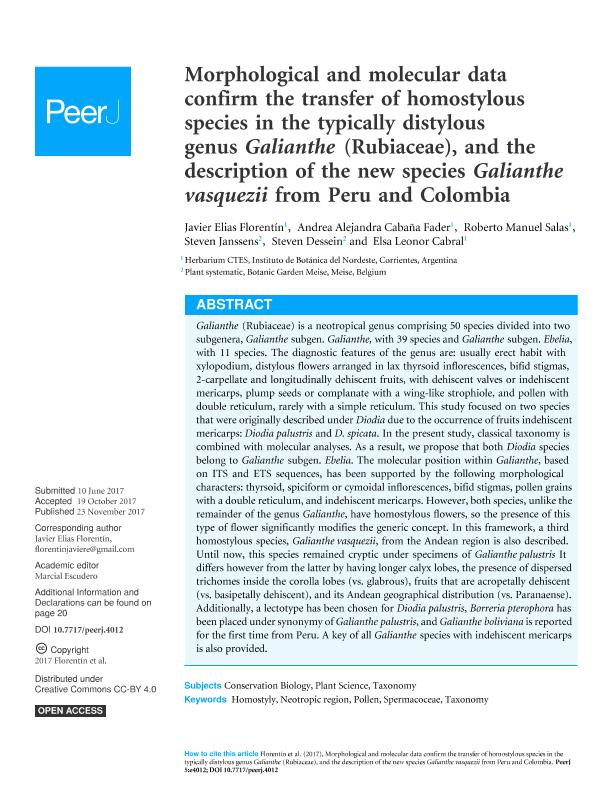Mostrar el registro sencillo del ítem
dc.contributor.author
Florentín, Javier Elias

dc.contributor.author
Cabaña Fader, Andrea Alejandra

dc.contributor.author
Salas, Roberto Manuel

dc.contributor.author
Janssens, Steven
dc.contributor.author
Dessein, Steven

dc.contributor.author
Cabral, Elsa Leonor

dc.date.available
2018-04-27T19:11:21Z
dc.date.issued
2017-11
dc.identifier.citation
Florentín, Javier Elias; Cabaña Fader, Andrea Alejandra; Salas, Roberto Manuel; Janssens, Steven; Dessein, Steven; et al.; Morphological and molecular data confirm the transfer of homostylous species in the typically distylous genus Galianthe (Rubiaceae), and the description of the new species Galianthe vasquezii from Peru and Colombia; PeerJ Inc.; PeerJ; 2017; 11; 11-2017; 1-23
dc.identifier.issn
2167-8359
dc.identifier.uri
http://hdl.handle.net/11336/43695
dc.description.abstract
Galianthe (Rubiaceae) is a neotropical genus comprising 50 species divided into two subgenera, Galianthe subgen. Galianthe, with 39 species and Galianthe subgen. Ebelia, with 11 species. The diagnostic features of the genus are: usually erect habit with xylopodium, distylous flowers arranged in lax thyrsoid inflorescences, bifid stigmas, 2-carpellate and longitudinally dehiscent fruits, with dehiscent valves or indehiscent mericarps, plump seeds or complanate with a wing-like strophiole, and pollen with double reticulum, rarely with a simple reticulum. This study focused on two species that were originally described under Diodia due to the occurrence of fruits indehiscent mericarps: Diodia palustris and D. spicata. In the present study, classical taxonomy is combined with molecular analyses. As a result, we propose that both Diodia species belong to Galianthe subgen. Ebelia. The molecular position within Galianthe, based on ITS and ETS sequences, has been supported by the following morphological characters: thyrsoid, spiciform or cymoidal inflorescences, bifid stigmas, pollen grains with a double reticulum, and indehiscent mericarps. However, both species, unlike the remainder of the genus Galianthe, have homostylous flowers, so the presence of this type of flower significantly modifies the generic concept. In this framework, a third homostylous species, Galianthe vasquezii, from the Andean region is also described. Until now, this species remained cryptic under specimens of Galianthe palustris It differs however from the latter by having longer calyx lobes, the presence of dispersed trichomes inside the corolla lobes (vs. glabrous), fruits that are acropetally dehiscent (vs. basipetally dehiscent), and its Andean geographical distribution (vs. Paranaense). Additionally, a lectotype has been chosen for Diodia palustris, Borreria pterophora has been placed under synonymy of Galianthe palustris, and Galianthe boliviana is reported for the first time from Peru. A key of all Galianthe species with indehiscent mericarps is also provided.
dc.format
application/pdf
dc.language.iso
eng
dc.publisher
PeerJ Inc.
dc.rights
info:eu-repo/semantics/openAccess
dc.rights.uri
https://creativecommons.org/licenses/by-nc-sa/2.5/ar/
dc.subject
Homostyly
dc.subject
Neotropic Region
dc.subject
Pollen
dc.subject
Spermacoceae
dc.subject
Taxonomy
dc.subject.classification
Ciencias de las Plantas, Botánica

dc.subject.classification
Ciencias Biológicas

dc.subject.classification
CIENCIAS NATURALES Y EXACTAS

dc.title
Morphological and molecular data confirm the transfer of homostylous species in the typically distylous genus Galianthe (Rubiaceae), and the description of the new species Galianthe vasquezii from Peru and Colombia
dc.type
info:eu-repo/semantics/article
dc.type
info:ar-repo/semantics/artículo
dc.type
info:eu-repo/semantics/publishedVersion
dc.date.updated
2018-04-25T21:32:19Z
dc.identifier.eissn
2376-5992
dc.journal.volume
2017
dc.journal.number
11
dc.journal.pagination
1-23
dc.journal.pais
Estados Unidos

dc.description.fil
Fil: Florentín, Javier Elias. Consejo Nacional de Investigaciones Científicas y Técnicas. Centro Científico Tecnológico Conicet - Nordeste. Instituto de Botánica del Nordeste. Universidad Nacional del Nordeste. Facultad de Ciencias Agrarias. Instituto de Botánica del Nordeste; Argentina
dc.description.fil
Fil: Cabaña Fader, Andrea Alejandra. Consejo Nacional de Investigaciones Científicas y Técnicas. Centro Científico Tecnológico Conicet - Nordeste. Instituto de Botánica del Nordeste. Universidad Nacional del Nordeste. Facultad de Ciencias Agrarias. Instituto de Botánica del Nordeste; Argentina
dc.description.fil
Fil: Salas, Roberto Manuel. Consejo Nacional de Investigaciones Científicas y Técnicas. Centro Científico Tecnológico Conicet - Nordeste. Instituto de Botánica del Nordeste. Universidad Nacional del Nordeste. Facultad de Ciencias Agrarias. Instituto de Botánica del Nordeste; Argentina
dc.description.fil
Fil: Janssens, Steven. Botanic Garden Meise; Bélgica
dc.description.fil
Fil: Dessein, Steven. Botanic Garden Meise; Bélgica
dc.description.fil
Fil: Cabral, Elsa Leonor. Consejo Nacional de Investigaciones Científicas y Técnicas. Centro Científico Tecnológico Conicet - Nordeste. Instituto de Botánica del Nordeste. Universidad Nacional del Nordeste. Facultad de Ciencias Agrarias. Instituto de Botánica del Nordeste; Argentina
dc.journal.title
PeerJ
dc.relation.alternativeid
info:eu-repo/semantics/altIdentifier/doi/http://dx.doi.org/10.7717/peerj.4012
dc.relation.alternativeid
info:eu-repo/semantics/altIdentifier/url/https://peerj.com/articles/4012/
Archivos asociados
